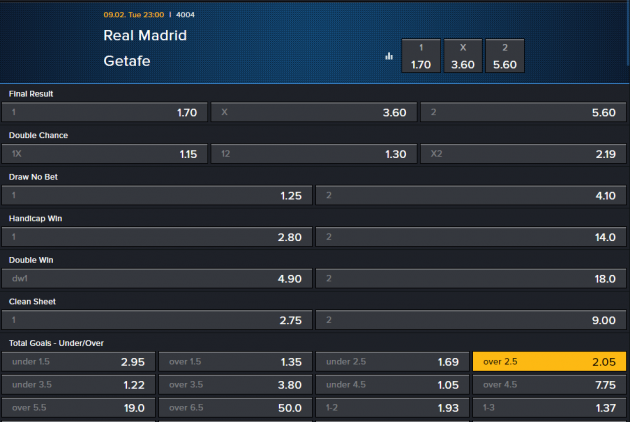What Is The Over And Under
Posted By admin On 03/04/22- What Is The Over And Under On The Super Bowl
- What Is The Over And Under On The Chiefs Game
- What Is The Over And Under In Sports Betting
- What Is The Over And Under In Sports Betting
- What Is The Over And Under On The Super Bowl Today
Armed Forces stand at the ready to counter China’s aggression, but questions are being raised over whether Joe Biden has the will to oppose Beijing. One America’s Hans Hubbard reports. The over/under, or “total,” is the second most popular bet on the board for sports events behind the point spread. Usually the over/under refers to the total points, runs or goals scored in a game.
What Is The Over And Under On The Super Bowl
An over–under or over/under (O/U) bet is a wager in which a sportsbook will predict a number for a statistic in a given game[1] (usually the combined score of the two teams), and bettors wager that the actual number in the game will be either higher or lower than that number.[2][3] For example, in Super Bowl XXXIX, most Las Vegascasinos set the over–under for the score of the game at 46.0. A bettor could wager that the combined score of the two teams would be either more than or less than that number. Since the combined score of that game was 45, anyone who had bet on 'under' won.
Initial and final value[edit]
The goal of a sportsbook is to have an equal value of bets on both sides of the over–under. In theory, this means that the manager could set the value at zero and then re-adjust based on either the number of incoming bets and/or events that influence the potential outcome. In practice, the initial value is based on both quantitative (e.g. win–loss record, average points per game, etc.) and anecdotal information (e.g. media reports, injury status of players, etc.).
As with other types of bets where the odds of either outcome are meant to be even, the vigorish (or 'vig') is typically set at or about 5% of the total wager. Using American odds, this will result in both outcomes initially being quoted at -110 (i.e. bettors must risk $110 to win $100). If the amount bet on both outcomes is exactly even, using such odds would result in the sportsbook earning $5 in gross profit for every $110 wagered.
Of course, bettors will not necessarily risk the same amount of money on both outcomes every time. In such circumstances, there are two ways a sportsbook can mitigate the risk. The first is to adjust the O/U while keeping the odds of both at -110. For example, if the O/U for a football game is set at 45.5 and the action heavily favors the 'over' then the O/U could be adjusted to 46.5 to encourage bettors to take the 'under.' The risk here is that the sportsbook could lose a lot of money by being 'middled' - using the aforementioned example, if the final combined score is 46 then the sportsbook would be obligated to pay both the initial bettors who bet 'over' and the later bettors who bet 'under.'
The other method to mitigate risk is to adjust the odds on the initial O/U, which is slightly more complicated but eliminates the risk of being 'middled.' In the aforementioned example, the 'under' could be adjusted to -105 while the 'over' is changed to -115 (meaning bettors would have to risk $105 and $115 respectively to win $100) in order to make the original 'under' proposition more attractive (and the 'over' less so) to bettors. In actual scenarios, even adjustments of -100 (i.e. 'even money') and -120 are common place as sportsbooks typically endeavor to maintain steady margins and minimize risk.

Statistics[edit]
What Is The Over And Under On The Chiefs Game
Though this bet is most commonly made with the combined score of the two teams, many other statistics can be used, including:
- In American football, a player's or team's total rushingyards or attempts, down conversions (first or third), interceptions, completions, field goal percentage, etc.
- In basketball, a player's or team's total assists, blocks, turnovers, steals, etc.
- In baseball, a player's or team's total number of home runs, RBIs, etc.
Dice[edit]
A variant of overunder betting, known as Under Over, is a dice game played at various festivals. The object of the game is to predict whether the dice will roll to a total of under 7, over 7, or at 7. The game is typically played with 2 dice.
A player typically places a wager on one of three spaces. These spaces are:
- Under 7 (usually pays 1–1)
- Over 7 (usually pays 1–1)
- 7 (usually pays 4–1)
For instance if one bets one dollar on under and the dealer rolls under, they gain a dollar as well as get their dollar back. If the dealer rolls a seven and one bets on it, they make four dollars. Once all the bets have been placed the attendant closes the betting board with a screen and then puts the dice through the chute. Players then get paid accordingly.
One variation of Under Over involves foam dice, two of which are thrown in the middle of the players; in another variation, two balls are thrown into a giant wheel consisting of twelve spaces of numbers ranging from 1–6. No wire fence is used to block the bets in that case.
References[edit]
- ^Kochan, M. (2013). Secrets of Professional Sports Betting. Cardoza Publishing. p. 12. ISBN978-1-58042-438-7. Retrieved April 25, 2015.
- ^Williams, L.V.; Siegel, D.S. (2014). The Oxford Handbook of the Economics of Gambling. Oxford Handbooks in Economics Series. OUP USA. p. 205. ISBN978-0-19-979791-2.
- ^Fodor's Las Vegas 2015. Full-color Travel Guide. Fodor's Travel Publications. 2014. ISBN978-0-8041-4300-4.
Among the most important accounting concepts for contractors and construction companies to understand are the concepts of over- and under-billings and work in process (or WIP).Not accounting for over- and under-billings and WIP accurately can lead to a host of financial problems for contractors, including cash flow shortfalls and “profit fade,” or the recognition of profit too early (or late) during the job cycle. In addition to potentially wreaking havoc on your finances, these problems can also be a major red flag for sureties and lenders.
What Are Over- and Under-Billings and WIP?
Most construction projects are long-term in nature, with invoicing and costs spread out over a long period of time. The challenge is to match up accounting for invoicing and costs as closely as possible to the actual construction progress that’s occurring on the project. For example, let’s say you have completed 25 percent of a construction project. Ideally, you will have billed out about 25 percent of the contracted amount at this point. For a variety of different reasons, though, it can be difficult to match up billings with the amount of work that has been completed (or work in progress).
What Is The Over And Under In Sports Betting
If you have invoiced 50 percent of the contract amount at the 25 percent project completion stage, you would be 25 percent over-billed. Conversely, if you have completed 50 percent of the project but have only invoiced 25 percent of the contract amount, you would be 25 percent under-billed. The problem with either scenario is that it results in an inaccurate monthly income (or profit-and-loss) statement. If you are over-billed, your P&L will reflect too much profit; if you’re under-billed, it will reflect too little profit.
Changes in projected costs, meanwhile, can result in profit fade. For example, suppose you are working on a one-year, $1 million project with projected expenses of $800,000. During the first six month, you bill half of the project total (or $500,000) and incur half of the expenses (or $400,000), realizing half of your projected profit (or $100,000). Expenses during the next six months, however, hit $500,000, bringing total costs up to $900,000 and dropping total profit to $100,000. But this profit was already realized during the first six months, which is now over-billed, resulting in profit fade during the next six months of $50,000.
Making a WIP Adjustment

Once you know the amounts that you are over- or under-billed, the next step is to post a WIP adjustment. This will enable you to utilize the matching principal — or in other words, to match your income and expenses to the same period of time — and produce an accurate monthly P&L.
Following are the steps for posting over- and under-billings
What Is The Over And Under In Sports Betting
- Make sure the contract amount and the job status are correct
- Make sure a budget has been entered
- Make sure all change orders have been posted and have the correct status
- Run the Over/Under Billings report for projects with current status with the correct posting period selected
- Post the over/under billing adjustment using the correct date and posting period Note: WIP adjustments are typically “reversed in next period”
To Learn More
What Is The Over And Under On The Super Bowl Today
There are many subtle nuances involved in contractor accounting, including the concepts of over- and under-billings and work in progress. If you have more questions about these concepts or need help implementing them into your accounting practices, please contact On Track Business Management at (530) 478-9234 or send us a message